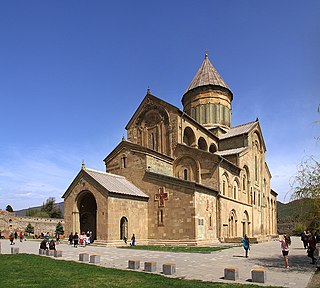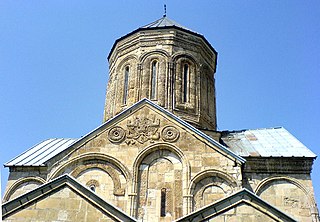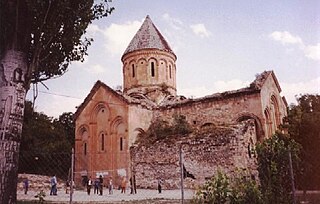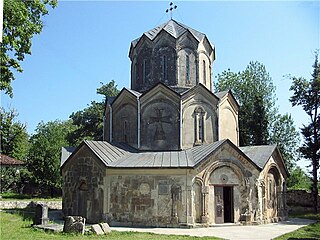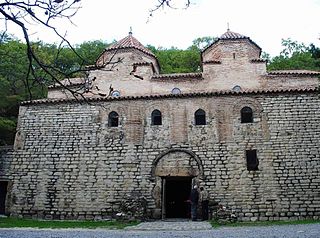
Kvatakhevi (Georgian :ქვათახევი) is a medieval Georgian Orthodox monastery in Shida Kartli, Georgia, 55 km (34 mi) west of the nation’s capital of Tbilisi.

Georgian is a Kartvelian language spoken by Georgians. It is the official language of Georgia. Georgian is written in its own writing system, the Georgian script. Georgian is the literary language for all regional subgroups of Georgians, including those who speak other Kartvelian languages: Svans, Mingrelians and the Laz.
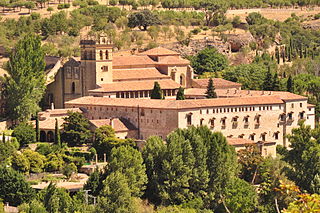
A monastery is a building or complex of buildings comprising the domestic quarters and workplaces of monastics, monks or nuns, whether living in communities or alone (hermits). A monastery generally includes a place reserved for prayer which may be a chapel, church, or temple, and may also serve as an oratory.

Shida Kartli is a landlocked administrative region (Mkhare) in eastern Georgia. Comprises a central part of the historical-geographic province of Shida Kartli. With an area of 5,729 square kilometres, Shida Kartli is the 8th largest Georgian region by land area. With 300,382 inhabitants, it is Georgia's seventh-most-populous region. Shida Kartli's capital and largest city, Gori, is the 5th largest city in Georgia.
The Kvatakhevi monastic complex is situated near the village Kavtiskhevi at the end of the gorge cut by a stream in the northern slopes of the Trialeti Range, protected on three sides by the steep mountain slopes. It dates to the 12th-13th century, and resembles the monasteries of Betania, Pitareti, and Timotesubani in its architectural form and decoration, reflecting a contemporary canon of a Georgian domed church architecture. The overall plan is nearly a square, with the dome resting upon 2 freely standing pillars and 2 pillars fused with the ledges of the altar. The internal space of the church is formed by the arms of the cross and the dome which surmounts the crossing point.

Trialeti Range is an east-west mountain range of the Lesser Caucasus Mountains in the central part of Georgia. The eastern edge of the Range runs along the western border of Tbilisi, while the western edge lies along River Mtkvari to the southwest of Borjomi. The length of the Trialeti Range is 144 kilometers and the maximum width is 30 kilometers. The mountain range was built up by volcanic activity during the Paleogene Era. Young, andesite lava flows are common in the western part of the Range. The highest point is Mount Shaviklde at an elevation of 2,850 meters above sea level (9,348 ft.). The slopes of the Range are mainly covered by deciduous forests made up of oak, beech, and hornbeam. The western parts of Trialeti are covered by coniferous and mixed forests made up of fir, spruce, pine, beech, and oak.
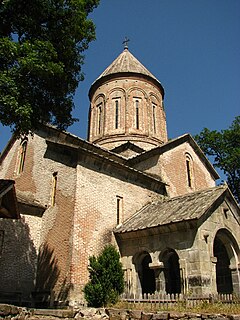
Timotesubani is a medieval Georgian Orthodox Christian monastic complex located at the eponymous village in the Borjomi Gorge, Georgia's Samtskhe-Javakheti region.
The building has two portals, one to the south and one to the west. The façades are covered with finely hewn white stone squares. The decoration abounds in fretwork, especially around the windows and the base of the dome; the eastern façade is adorned with a large ornate cross.
Historically, Kvatakhevi was also a literary center where several manuscripts were copied. It also possessed a treasure with many artifacts of medieval Georgian jewelry, a sizeable portion of which was later acquired by and are now on display at the Moscow State Historical Museum. [1]

Moscow is the capital and most populous city of Russia, with 13.2 million residents within the city limits, 17 million within the urban area and 20 million within the metropolitan area. Moscow is one of Russia's federal cities.

The State Historical Museum of Russia is a museum of Russian history wedged between Red Square and Manege Square in Moscow. Its exhibitions range from relics of prehistoric tribes that lived on the territory of present-day Russia, through priceless artworks acquired by members of the Romanov dynasty. The total number of objects in the museum's collection comes to millions.
The monastery was significantly damaged during Timur's invasions of Georgia in the 14th century, but was subsequently repaired, more completely under the patronage of Prince Ivane Tarkhan-Mouravi in 1854. A belfry was added in 1872.

Georgia, a Christian kingdom in the Caucasus, was subjected, between 1386 and 1403, to several disastrous invasions by the armies of Turco-Mongol conqueror Timur, whose vast empire stretched, at its greatest extent, from Central Asia into Anatolia. These conflicts were intimately linked with the wars between Timur (Tamerlane) and Tokhtamysh, the last khan of the Golden Horde and Timur’s major rival for control over the Islamic world. Timur officially proclaimed his invasions to be jihad against the region's non-Muslims. Although he was able to invade parts of Georgia, he was never able to make the country Muslim and even recognized Georgia to be a Christian state.

The Tarkhan-Mouravi is a Georgian noble family, claiming descent from the Shamkhal dynasty of Tarki, in Dagestan. Originally known as Saakadze (სააკაძე), they acquired, in the 1640s, the title of prince (tavadi) and the new surname, which is a composite of the two hereditary offices, mouravi and tarkhan. The family was reconfirmed as the princes (knyaz) by the Russian Empire in 1826 and 1850. The cadets continued to be called Saakadze and remained members of the untitled nobility (aznauri) until 1881 when they were also elevated to the princely rank.
| Wikimedia Commons has media related to Kvatakhevi church . |






